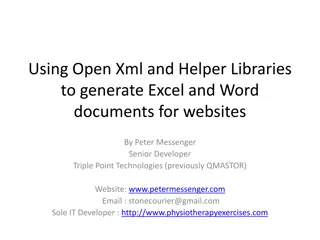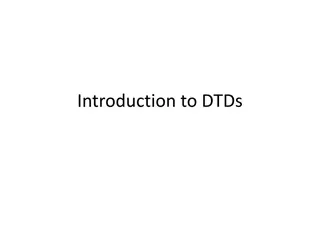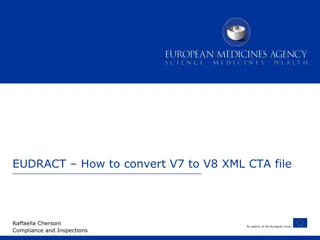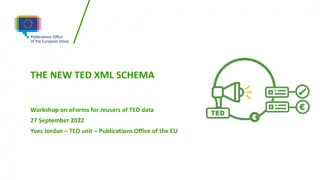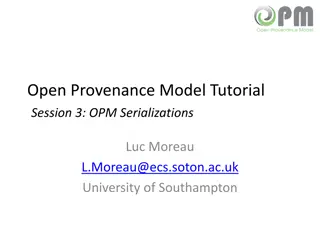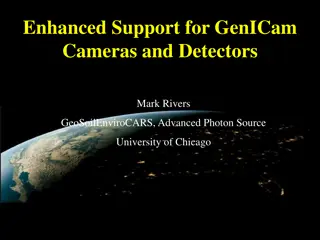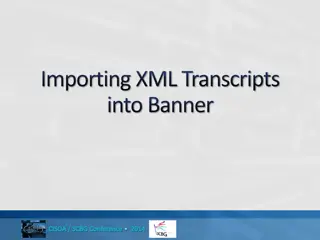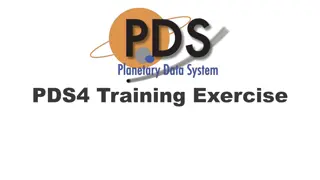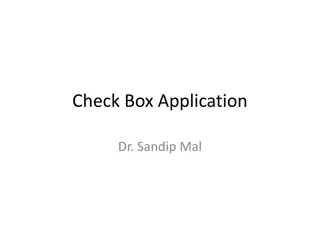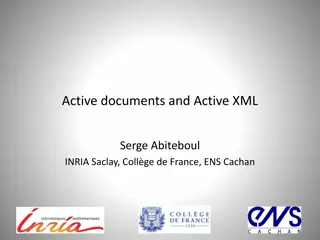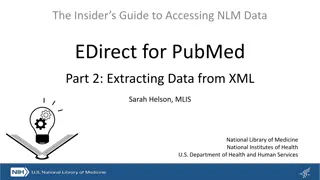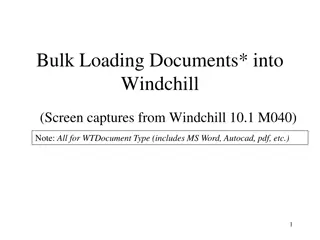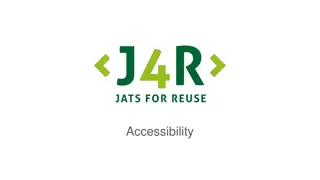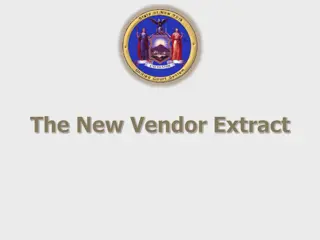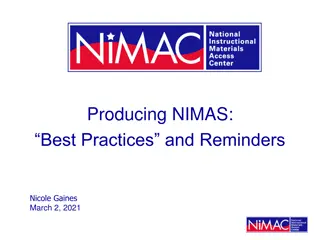XML
XML stands for eXtensible Markup Language. It is a markup language similar to HTML but designed to store and transport data. XML describes data in a way that can be understood by humans and processed by computers. Unlike HTML, XML does not focus on how data looks but on carrying data in a structured manner. XML allows authors to define their own tags and document structure, making it extensible and versatile. XML documents contain text representing content with specific structural elements, such as elements, attributes, and more.
Download Presentation

Please find below an Image/Link to download the presentation.
The content on the website is provided AS IS for your information and personal use only. It may not be sold, licensed, or shared on other websites without obtaining consent from the author.If you encounter any issues during the download, it is possible that the publisher has removed the file from their server.
You are allowed to download the files provided on this website for personal or commercial use, subject to the condition that they are used lawfully. All files are the property of their respective owners.
The content on the website is provided AS IS for your information and personal use only. It may not be sold, licensed, or shared on other websites without obtaining consent from the author.
E N D
Presentation Transcript
INTRODUCTION XML stands for eXtensible Markup Language. XML is a markup language much like HTML XML was designed to store and transport data XML describes data in a way that human beings can understand and computers can process.
HTML Vs. XML XML was designed to carry data - with focus on what data is. HTML was designed to display data - with focus on how data looks. XML tags are not predefined like HTML tags.
XML XML does not carry any information about how to be displayed. The same XML data can be used in many different presentation scenarios. XML is extensible- XML allows the author to define his own tags and his own document structure.
XML Document: Eg XML declaration : it defines the version of the XML <?xml version="1.0"?> <note> <to>John</to> <from>Jani</from> <heading>Reminder</heading> <body>Don't forget me this weekend!</body> </note> Root element Child elements of root: to, from, heading,body
XML Document XML documents contain text that represents content(ie data). Eg: John Elements specify the document s structure. Eg:to XML documents delimit elements with start tags and end tags. Every XML document must have exactly one root element that contains all the other elements. XML tags are case sensitive.
XML ELEMENT An XML element is everything from (including) the element's start tag to (including) the element's end tag. An element can contain text, attributes , other elements etc. Syntax: <element-name attribute1 attribute2> ....content </element- name> Eg:<price>29.99</price> XML element name can be of any length and begins with either a letter or an underscore. It cannot begins with xml in any combination.
XML: Attribute An element can have multiple unique attributes. Attribute gives more information about XML elements. An XML attribute is always a name-value pair. Eg: <person gender="female">
In XML the attribute value must always be quoted. <?xml version="1.0"?> <note date="12/11/99"> <to>Tove</to> <from>Jani</from> <heading>Reminder</heading> <body>Don't forget me this weekend!</body> </note> XML attributes are normally used to describe XML elements, or to provide additional information about elements.
Elements vs. Attributes <person gender="female"> <firstname>Anna</firstname> <lastname>Smith</lastname> </person> here gender is an attribute <person> <gender>female</gender> <firstname>Anna</firstname> <lastname>Smith</lastname> </person> Here gender is an element
attributes cannot contain multiple values (elements can) attributes cannot contain tree structures (elements can) attributes are not easily expandable (for future changes)
XML References References usually allow to add or include additional text or markup in an XML document. References always begin with the symbol "&" ,which is a reserved character and end with the symbol ";" XML has two types of references: Entity References: Eg: incorrect: <message>salary < 1000</message> Correct: <message>salary < 1000</message> Character References: These contain references, such as A, contains a hash mark ( # ) followed by a number. Number refers to the Unicode code of a character
Entity reference < < less than > > greater than & & ampersand ' ' apostrophe " " quotation mark
Processing XML document Processing an XML document requires software called an XML parser (or XML processor). A parser makes the document s data available to applications While reading an XML document s contents, a parser checks that the document follows the syntax rules specified by the W3C s XML Recommendation.
Validating XML Documents An XML document can reference a Document Type Definition (DTD) or a schema that defines the document s proper structure. When an XML document references a DTD or a schema, some parsers (called validating parsers) can read it and check that the XML document follows the structure it defines. If the XML document conforms to the DTD/schema (i.e., has the appropriate structure), the document is valid.
Well Formed XML A "Well Formed" XML document has correct XML syntax. XML documents must have a root element XML elements must have a closing tag XML tags are case sensitive XML elements must be properly nested XML attribute values must be quoted
XML: Namespace In XML, element names are defined by the developer. This often results in a conflict when trying to mix XML documents from different XML applications. < - - XML carries HTML table information - -> <table> <tr> <td>Apples</td> <td>Bananas</td> </tr> </table> < - - XML carries information about table - -> <table> <name>African CoffeeTable</name> <width>80</width> <length>120</length> </table>
Name conflicts in XML can easily be avoided using a name prefix. <h:table> <h:tr> <h:td>Apples</h:td> <h:td>Bananas</h:td> </h:tr> </h:table> <f:table> <f:name>African Coffee Table</f:name> <f:width>80</f:width> <f:length>120</f:length> </f:table>
When using prefixes in XML, a namespace for the prefix must be defined. An XML namespace is a collection of element and attribute names. XML namespaces provide a means for document authors to unambiguously refer to elements with the same name (i.e., prevent collisions). The namespace can be defined by an xmlns attribute in the start tag of an element. Syntax: xmlns : prefix="URI".
<root xmlns:h="http://www.w3.org/TR/html4/" xmlns:f="https://www.w3schools.com/furniture"> <h:table> <h:tr> <h:td>Apples</h:td> <h:td>Bananas</h:td> </h:tr> </h:table> <f:table> <f:name>African Coffee Table</f:name> <f:width>80</f:width> <f:length>120</f:length> </f:table> </root>
Default Namespaces Defining a default namespace for an element saves us from using prefixes in all the child elements. Syntax: xmlns="namespaceURI Eg: <table xmlns="http://www.w3.org/TR/html4/"> <tr> <td>Apples</td> <td>Bananas</td> </tr> </table>
DTD DTD is a Document Type Definition It is used to specify XML document structure. DTD describes the structure of an XML document and enables an XML parser to verify whether an XML document is valid. DTDs allow users to check document structure and to exchange data in a standardized format.
XML provides an application independent way of sharing data. With a DTD, independent groups of people can agree to use a common DTD for interchanging data. Application can use a standard DTD to verify that data that you receive from the outside world is valid. You can also use a DTD to verify your own data.
Internal DTD Declaration <?xml version="1.0"?> <!DOCTYPE note [ <!ELEMENT note (to,from,heading,body)> <!ELEMENT to (#PCDATA)> <!ELEMENT from (#PCDATA)> <!ELEMENT heading (#PCDATA)> <!ELEMENT body (#PCDATA)> ]> <note> <to>Tove</to> <from>Jani</from> <heading>Reminder</heading> <body>Don't forget me this weekend</body> </note>
!DOCTYPE note defines that the root element of this document is note !ELEMENT note defines that the note element must contain four elements: "to,from,heading,body" !ELEMENT to defines the to element to be of type "#PCDATA PCDATA means parsed character data(i.e., data that s processed by an XML parser). Elements with parsed character data cannot contain markup characters, such as less than (<), greater than (>) or ampersand (&).
External DTD Declaration <?xml version="1.0"?> <!DOCTYPE note SYSTEM "note.dtd"> <note> <to>Tove</to> <from>Jani</from> <heading>Reminder</heading> <body>Don't forget me this weekend!</body> </note>
DOCTYPE The DOCTYPE reference contains three items: The name of the root element that the DTD specifies (Note); The keyword SYSTEM (which denotes an external DTD a DTD declared in a separate file, as opposed to a DTD declared locally in the same file); DTD s name and location DTD document filenames typically end with the .dtd extension. Eg: <!DOCTYPE note SYSTEM "note.dtd">
<!- -letter.dtd - -> <?xml version = "1.0"?> <!-- Fig. 15.4: letter.xml --> <!-- Business letter marked up with XML --> <!DOCTYPE letter SYSTEM "letter.dtd"> <letter> <contact type = "sender"> <name>Jane Doe</name> <address1>Box 12345</address1> <address2>15 Any Ave.</address2> <city>Othertown</city> <state>Otherstate</state> <zip>67890</zip> <phone>555-4321</phone> <flag gender = "F" /> </contact> <salutation>Dear Sir:</salutation> <paragraph>It is our privilege to inform you about our new database </paragraph> <paragraph>Please visit our website for availability and pricing. </paragraph> <closing> Sincerely,</closing> <signature> Ms. Jane Doe </signature> </letter> <!ELEMENT letter ( contact+, salutation, paragraph+, closing, signature )> <!ELEMENT contact ( name, address1, address2, city, state, zip, phone, flag )> <!ATTLIST contact type CDATA #IMPLIED> <!ELEMENT name ( #PCDATA )> <!ELEMENT address1 ( #PCDATA )> <!ELEMENT address2 ( #PCDATA )> <!ELEMENT city ( #PCDATA )> <!ELEMENT state ( #PCDATA )> <!ELEMENT zip ( #PCDATA )> <!ELEMENT phone ( #PCDATA )> <!ELEMENT flag EMPTY> <!ATTLIST flag gender (M | F) "M"> <!ELEMENT salutation ( #PCDATA )> <!ELEMENT closing ( #PCDATA )> <!ELEMENT paragraph ( #PCDATA )> <!ELEMENT signature ( #PCDATA )>
Defining Elements in a DTD The plus sign (+) occurrence indicator specifies that the DTD requires one or more occurrences of an element. Other occurrence indicators include the asterisk (*), which indicates an optional element that can occur zero or more times, and the Question mark (?), which indicates an optional element that can occur at most once (i.e., zero or one occurrence). If an element does not have an occurrence indicator, the DTD requires exactly one occurrence.
Defining Attributes in a DTD ATTLIST attribute-list declaration to define an attribute name. Keyword #IMPLIED specifies that if the parser finds an element without a type attribute, the parser can choose an arbitrary value for the attribute or can ignore the attribute. #REQUIRED specifies that the attribute must be present in the element. #FIXED specifies that the attribute (if present) must have the given fixed value. Eg:<!ATTLIST address zip CDATA #FIXED "01757">
Keyword EMPTY specifies that the element does not contain any data between its start and end tags. Empty elements commonly describe data via attributes.
XML: SCHEMA Many developers in the XML community believe that DTDs are not flexible enough to meet today s programming needs. For example, DTDs lack a way of indicating what specific type of data (e.g., numeric, text) an element can contain, and DTDs are not themselves XML documents, forcing developers to learn multiple grammars and developers to create multiple types of parsers. These and other limitations have led to the development of schemas. Unlike DTDs, schemas do not use EBNF grammar. Instead, they use XML syntax and are actually XML documents that programs can manipulate.
XML: SCHEMA A DTD describes an XML document s structure, not the content of its elements. For eg: <quantity>5</quantity> contains character data. If the document that contains element quantity references a DTD, an XML parser can validate the document to confirm that this element indeed does contain PCDATA content. However, the parser cannot validate that the content is numeric; DTDs do not provide this capability. So, the parser also considers for eg: <quantity>hello</quantity> to be valid.
XML: SCHEMA XML Schema enables schema authors to specify that element quantity s data must be numeric or, even more specifically, an integer. A parser validating the XML document against this schema can determine that 5 conforms and hello does not. An XML document that conforms to a schema document is schema valid, and one that does not conform is schema invalid. Schemas are XML documents and therefore must themselves be valid.
XML: SCHEMA An XML Schema describes the structure of an XML document. The XML Schema language is also referred to as XML Schema Definition (XSD). An XML XSD is kept in a separate document and then the document can be linked to an XML document to use it.
Example <?xml version="1.0"?> <xs:schema xmlns:xs="http://www.w3.org/2001/ XMLSchema" targetNamespace="https://www.w3schools.com" xmlns="https://www.w3schools.com" elementFormDefault="qualified"> XML SCHEMA XML document <?xml version="1.0"?> <note> <to>Tove</to> <from>Jani</from> <heading>Reminder</heading> <body>Don't forget me this weekend!</body> </note> <xs:element name="note"> <xs:complexType> <xs:sequence> <xs:element name="to" type="xs:string"/> <xs:element name="from" type="xs:string"/> <xs:element name="heading" type="xs:string"/> <xs:element name="body" type="xs:string"/> </xs:sequence> </xs:complexType> </xs:element> </xs:schema>
XML Schema Document The file extension is .xsd The root element is <schema> The XSD starts like this: <?xml version="1.0"?> <xs:schema xmlns:xs="http://www.w3.rg/2001/XMLSchema"> Indicates that the elements and data types used in the schema come from the "http://www.w3.org/2001/XMLSchema" namespace.
The <schema> element may have attributes: xmlns:xs="http://www.w3.org/2001/XMLSchema" This is necessary to specify where all our XSD tags are defined elementFormDefault="qualified" This means that all XML elements must be qualified (use a namespace) It is highly desirable to qualify all elements, or problems will arise when another schema is added
Simple and complex elements A simple element is one that contains text and nothing else A simple element cannot have attributes A simple element cannot contain other elements A simple element cannot be empty However, the text can be of many different types, and may have various restrictions applied to it If an element isn t simple, it s complex A complex element may have attributes A complex element may be empty, or it may contain text, other elements, or both text and other elements
Defining a simple element A simple element is defined as <xs:element name="name" type="type" /> where: name is the name of the element the most common values for type are xs:boolean xs:date xs:decimal Other attributes a simple element may have: default="default value"if no other value is specified fixed="value" xs:integer xs:string xs:time no other value may be specified
XML element <lastname>Refsnes</lastname> <age>36</age> <dateborn>1970-03-27</dateborn> Schema Element definition: <xs:element name="lastname" type="xs:string"/> <xs:element name="age" type="xs:integer"/> <xs:element name="dateborn" type="xs:date"/>
Defining attribute Attributes themselves are always declared as simple types An attribute is defined as <xs:attribute name="name" type="type" /> where: name and type are the same as for xs:element Other attributes a simple element may have: default="defaultvalue"if no other value is specified fixed="value" no other value may be specified use="optional" the attribute is not required (default) use="required" the attribute must be present
Eg: XML with attribute <lastname lang="EN">Smith</lastname> Attribute definition in XML <xs:attribute name="lang" type="xs:string"/> Assigning default value <xs:attribute name="lang" type="xs:string" default="EN"/ >
Complex element A complex element is defined as <xs:element name="name"> <xs:complexType> ... information about the complex type... </xs:complexType> </xs:element> Example: <xs:element name="person"> <xs:complexType> <xs:sequence> <xs:element name="firstName" type="xs:string" /> <xs:element name="lastName" type="xs:string" /> </xs:sequence> </xs:complexType> </xs:element> <xs:sequence> says that elements must occur in this order
XSD restrictions/facets Restrictions are used to define acceptable values for XML elements or attributes. The general form for putting a restriction on a text value is: <xs:element name="name"> <xs:restriction base="type"> ... the restrictions ... </xs:restriction> </xs:element> For example: <xs:element name="age"> <xs:restriction base="xs:integer"> <xs:minInclusive value="0"> <xs:maxInclusive value="140"> </xs:restriction> </xs:element> (or xs:attribute)
Restrictions on number minInclusive -- number must be the given value minExclusive -- number must be > the given value maxInclusive -- number must be the given value maxExclusive -- number must be < the given value totalDigits -- number must have exactly valuedigits fractionDigits -- number must have no more than valuedigits after the decimal point
Restrictions on strings length -- the string must contain exactly value characters minLength -- the string must contain at least value characters maxLength -- the string must contain no more than valuecharacters pattern -- the valueis a regular expression that the string must match
Reference to an XML schema <?xml version="1.0"?> <note xmlns="https://www.w3schools.com" xmlns:xsi="http://www.w3.org/2001/XMLSchema- instance" xsi:schemaLocation="https://www.w3schools.com note.xsd"> <to>Tove</to> <from>Jani</from> <heading>Reminder</heading> <body>Don't forget me this weekend!</body> </note>
XML Vocabularies XML allows authors to create their own tags to describe data precisely. People and organizations in various fields of study have created many different kinds of XML for structuring data. Some of these markup languages are: MathML (Mathematical Markup Language), Scalable Vector Graphics (SVG) Wireless Markup Language (WML) Extensible Business Reporting Language (XBRL) Extensible User Interface Language(XUL) Product Data Markup Language (PDML) Two other examples of XML vocabularies are W3C XML Schema and the Extensible Stylesheet Language (XSL),


